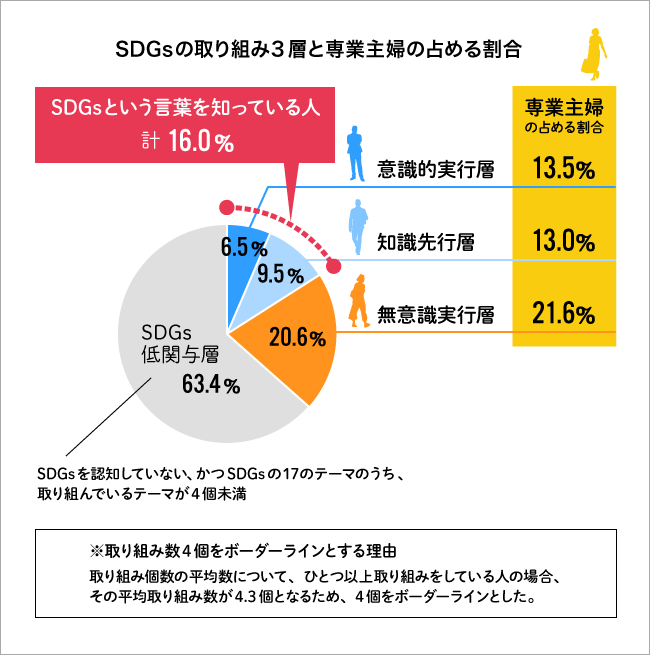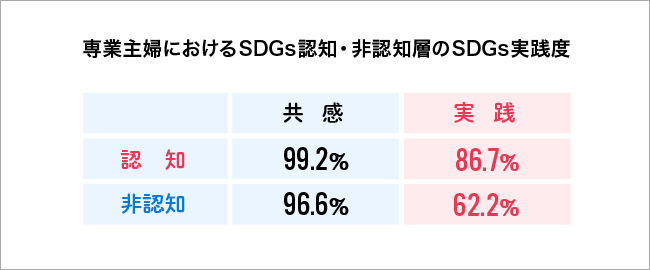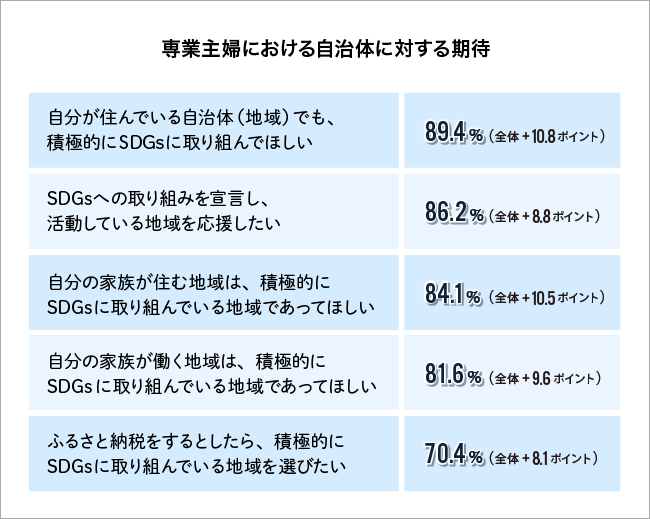This report presents analysis and insights regarding women, based on results from the "Second Survey on SDGs Awareness Among Consumers" conducted in February 2019.
Currently, women's awareness of the SDGs stands at 11.6%, roughly half that of men at 20.5%. However, analyzing their points of interest and resonance with the SDGs, along with their actual practice levels, revealed a level of engagement with the SDGs that was difficult to discern solely from their low awareness rate.
Full-time homemakers show the highest SDGs practice rate
Looking at "SDG Practice Levels," certain attributes stood out among women overall.
After explaining each of the 17 goals,
* Whether they buy products from or invest in companies working on this goal
• Participating in NPOs or organizations working toward this goal
• Are you personally taking action for this goal?
and classifying those who answered yes to any of these as "practicing" regardless of their awareness of the SDGs, the practice rate among full-time married women (58.3%) and full-time unmarried women (44.6%) was lower compared to full-time homemakers, who had the highest practice rate at 64.9% among all attributes.
This report will focus specifically on this group of full-time homemakers.
It should be noted that the full-time housewife group includes a significant number of the "Unconscious Practitioners" introduced in the first installment. Unconscious Practitioners are individuals who "were unaware of the SDGs but were working towards many of the goals." They account for 20.6% of the total, a higher proportion than the 16% of SDG-aware individuals.
Among this Unconscious Execution Group, full-time homemakers accounted for 21.6%. This highlights the higher proportion of full-time homemakers within the Unconscious Execution Group compared to the 13.5% found among the Conscious Execution Group and the 13.0% among the Knowledge-First Group.
While full-time homemakers showed high "SDG implementation levels," what specific actions are they taking?
Organizing their practice levels by specific goal reveals the following:
"6: Ensure availability and sustainable management of water and sanitation for all" was approximately 8 percentage points higher than the overall average, "3: Ensure healthy lives and promote well-being for all at all ages" was about 5 points higher, and "12: Responsible consumption and production" was roughly 4.5 points higher than the overall average.
Specifically, they appear to be practicing numerous familiar actions closely integrated into daily life, such as consciously conserving electricity and water, undergoing health checkups, using eco-bags, and purchasing refill packs.
Furthermore, when analyzing full-time homemakers by SDG awareness (aware vs. unaware), the practice rate among the larger unaware group was 62.2%, while the aware group's practice rate was 86.7%—a full 24.5 percentage points higher. While full-time homemakers demonstrate high practice rates even without SDG awareness, becoming aware of the SDGs appears to significantly boost their implementation.
This suggests that communication efforts to raise SDG awareness among full-time homemakers could accelerate SDG adoption and position them as drivers for achieving the goals.
Expectations for SDG Implementation and Usage Intentions Among Full-Time Housewives
Finally, we examine the expectations of full-time homemakers regarding SDG implementation by local governments and companies.
Regarding local governments, strong intentions were expressed, such as "I want my local government (community) to actively engage with the SDGs" and "I want to support regions that declare and actively pursue SDG initiatives." Items linking to actual practice, such as "If I were to make a hometown tax donation, I would choose a region actively pursuing the SDGs," showed results approximately 8 percentage points higher than the overall average.
Furthermore, regarding the intention to choose products and services from companies related to the SDGs, the figure was 46.1% among full-time homemakers, nearly 10 points higher than the overall average of 36.9%. This result indicates the potential for their willingness to support SDG implementation to be reflected in their consumption behavior.
As shown above, Dentsu Inc. Team SDGs enables multifaceted analysis of SDGs not only by gender and age group but also by attributes such as student status, occupation, and household income.
In the next installment, we will introduce key topics for each of the 17 goals.








